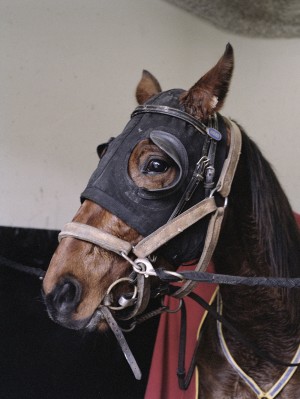The Corcoran Gallery of Art: Coast To Coast Dreaming
It’s a weighty enterprise but one she has approached with formality and great respect. In the rich brown tints of her images, she has embraced the classical portraiture of the Dutch Golden Age, the country of her upbringing. It’s not an exaggeration to say that her reverence for Rembrandt van Rijn shows in the final product. In this series, she positioned herself for hours in the animals’ habitats, gaining their trust before photographing them at eye level. The quietude of the poses — in Ringo, a frontal view and Peter, at rest with legs tucked under in sleep — proves this out. This portion of the exhibit was commissioned by the Corcoran as part of their NOW series to showcase mid-career and emerging artists.
The exhibition also features works from three other series. Reverie from 2005 depicts gray wolves in nature preserves in Sweden, Norway and the U.S. Palermo 7 (2006) includes close-ups of race horses, tethered in their stalls, and Heart Shaped Hole is a moving investigation of stray dogs, adapting in various ways in the streets of Palermo, Italy.
Born in the Netherlands in 1977, Dumas resides in Amsterdam and New York City but travels the world in search of her subjects. She received widespread acclaim for her photographs of the surviving search and recovery dogs of 9/11. “The bond between mankind and animals, and the extensive history that it accompanies, is my great interest,” she claims. Her goal is to engender a visual relationship that makes us more conscious of how we look at animals in our everyday lives. She believes that our own view of these animals’ circumstances will provoke us to examine our own role in their stories. We can only hope that more people have an opportunity to witness the rare portraiture of this committed young artist.
As a side observation, during my visit to both the Diebenkorn and Dumas exhibits, a performance installation was in progress, featuring a piece by Maida Withers. This past summer Saturday series entitled Take it to the Bridge was held just inside the Corcoran’s glass entryway. Upon entering, I was aware of a group of visitors sitting on the steps and could observe Withers encased in a glass box overhead. I didn’t pay too much attention to this activity until I reached the second floor, and the deafening shrill onslaught from human screams and recorded sound commenced. I and everyone else attempting to engage in other exhibits endured this assault for most of our visit. There is no doubt that considerable curatorial thought went into the series and the Corcoran can be congratulated for its many educational programs available to the public at any given time. But there must be a better way to schedule and harmonize the number of exhibits and events we’ve come to expect from this major institution.
The Corcoran Gallery
The gallery serves as a privately funded institution, founded in 1869. It was America’s first dedicated art museum and today is Washington’s largest nonfederal museum of art. That distinction has contributed greatly to its dynamic scheduling of special exhibitions and educational programming available to the public. The Corcoran College of Art & Design, founded in 1890, stands as Washington’s only four-year college of art and design. The permanent collection galleries are impressive, both in content and scope. These include: Historic American Art, European Art, Modern and Contemporary Art Since 1945, and Photography and Media Arts. The roster is rich with the likes of Camille Corot, Edgar Degas, Mary Cassatt, Frederic Edwin Church, John Singer Sargent, Ellsworth Kelly and many, many more.
Fall exhibits include Taryn Simon: A Living Man Declared Dead and Other Chapters I-XVIII, a series of 18 bloodlines that the photographer chronicled around the world. Enoc Perez: Utopia will feature the work of this contemporary painter and Ivan Sigal: White Road will introduce 100 new photographs of Central Asia.
The autumn months have plenty to offer in this artistic oasis and in retrospect are a getaway from one’s everyday lives. Diebenkorn found that escape in his dreamlike palette, Dumas found it in the transforming glance between humans and our animal kin. As nature loses its colors, leaving the trees bare, the Corcoran Gallery stands as a place where the trees are always green and creativity is there — waiting for our perpetual discovery.
Corcoran Gallery of Art is located at 500 Seventeenth Street NW, Washington, DC 20006. For more information concerning the museum or exhibits call (202)639-1700 or visit www.corcoran.org.


